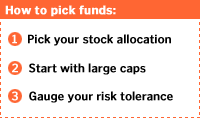
NEW YORK (MONEY) -
We've selected our 100 favorites. Now it's your turn to narrow down the list to fit your own needs -- that is, your investment goals and risk tolerance. Aficionados may want to jump right in and browse the tables.
Overwhelmed and wondering where to begin? You could start by taking a look at what you now own. If you've already got the large-cap basics covered, then you can head to the small-cap section of the table to read about picks that can add an edge. Also check to see how your current funds stack up against the ones we like. Perhaps you'll choose to trade up, particularly if you're investing via a 401(k) or an IRA and don't have to take taxes into account should you sell any of your current holdings.

As you weigh your options, think about balancing large-cap picks with smaller-cap funds, and funds that follow value-oriented strategies with more aggressive growth picks. We have grouped diversified domestic funds by market cap.
You can also check out a fund's five largest holdings to see how much overlap it has with your current or prospective picks. You'll find, for example, that Vanguard Tax-Managed Capital Appreciation -- which we added precisely for people who don't want to worry about taxes in an ordinary account -- has a lot in common with the Vanguard 500 Index and might not make a good supplement to a core index fund, even though it is more growth-oriented.
To help you make your choices, we constructed three model portfolios using funds from the 100.
| The Money 100
|

|
|
|
|
MODERATE PORTFOLIO. Let's say you have a reasonable amount of risk tolerance and can afford short-term losses because your goals -- whether the kids' college, a new house or retirement -- are seven to 10 years in the future. A typical allocation guideline for such a case would put 35 percent in large-cap funds, 15 percent in mid/small-cap funds; 10 in funds that own foreign stocks and 40 percent in bond funds.
Suppose that you anchor your portfolio with a broadly diversified large-cap fund, say Oppenheimer Main Street Growth & Income or Vanguard 500 Index. You might round that out with a midcap growth portfolio such as Calamos Growth, which would have added pop in 1999, and then set that pick off by value-oriented small-cap fund Royce Micro-Cap, one of the best places to be when growth crashed in 2000. Artisan International would add foreign growth stocks to the mix without getting reckless; Oakmark International applies Oakmark's renowned value formula overseas.
CONSERVATIVE PORTFOLIO. As sensible as our moderate proposal may be, it might nevertheless be a bit much for investors who dread downturns or can't afford a misstep because they are low on ready cash and planning to retire soon. Conservative investors will stash more cash in bonds and stick with low-risk stock investments. Large-cap value fund T. Rowe Price Equity-Income could conceivably lose money, but it hasn't in any one year since 1990, thanks to an old-fashioned emphasis on dividend-paying stocks. A growth-oriented -- but still eminently sensible -- large-cap pick such as American Funds' Growth Fund of America might be tempered by a small stake in an income-oriented real estate fund such as Cohen & Steers Realty Shares, which is leaps and bounds ahead of the S&P 500 over the past three years. Tweedy Browne American Value and T. Rowe Price Small-Cap Stock would add midcap and small-cap oomph. Meanwhile, Putnam International Growth would provide foreign-stock diversification.
AGGRESSIVE PORTFOLIO. There are the iron-stomached investors who didn't even flinch when they opened last quarter's statements. And then there are those who are planning on working and saving for another decade or more. But even if you are a daredevil with time to kill, you might want to kick things off with a reliable large-cap index fund. Vanguard 500 Index is the classic choice; Vanguard Calvert Social Index is an alternative for socially conscious investors. Marsico Focus would add highly concentrated spice; RS MidCap Opportunities would pump up the growth.
(Note that RS MidCap Opportunities is best sheltered in a tax-advantaged account. The fund's rapid-trading strategy is profitable but not tax-efficient, and you will maximize growth by postponing taxes in a 401(k) or traditional IRA or by avoiding them altogether in a Roth IRA.)
Even value picks needn't be stodgy. Bob Rodriguez flouts conventional wisdom at small-cap FPA Capital with controversial picks like insurer Conseco, and Wally Weitz has loaded up Weitz Value with floundering midcap telecom and media names. With a broad foundation laid, a few flourishes can add dash without courting structural damage: An aggressive investor might divert some of his or her stock stake to a 5 percent position in Pimco RCM Global Technology or SSgA Emerging Markets, for example.
The three asset-allocation options described here are just several of many ways to slice the pie. For more on allocating assets, get a refresher on the basics, or use our calculator to measure your own risk tolerance and time horizon. Brokerages such as Fidelity and Schwab offer similar online tools, as do major fund companies such as T. Rowe Price (www.troweprice.com) and Vanguard (www.vanguard.com).

|

